|
----
 ----
----
Adopted
Rose Bed: 
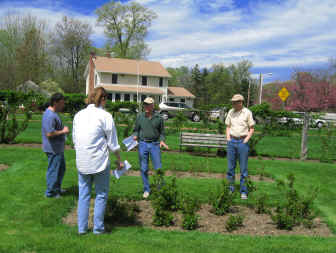
Thanks to Martha, Kenyon Streeters have adopted a
rose bed at Elizabeth Park again for 2008. This means that Martha, Mildred,
Victoria and I have volunteered to pull weeds and prune the dead
blossoms off the roses in our bed for this year.
Feel free to pull any weeds we have missed when you visit the
park.
We have bed #308, located just opposite the Info
Center (also just opposite a bench just inside the rose
garden).
#308 is in the second row from the edge. Our roses are
"Weeping China Doll".
See a diagram
of the rose garden, and all the varieties planted in the 474
beds.
----
 ----
----
Elizabeth
Park Centennial Roses on Kenyon: 
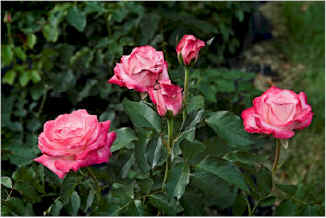
Picture with permission of Elizabeth
Park
Thanks to Doug, Kenyon Streeters are planting 15
of Elizabeth Park's Centennial roses in our gardens.
They arrived on May 5, 2007.
The Elizabeth Park Centennial Rose was bred
especially for
Elizabeth Park's 100th birthday. order
form rose
care
For those who have Japanese beetles eating your roses - Doug reports
great success by using a product:
Spectracide:
Systemic Rose & Flowering Shrub Insect Control + Fertilizer.
Elizabeth Park Centennial Rose
The long awaited Elizabeth Park Centennial Rose is in the Rose Garden.
It is a beautiful, pale pink, with a raspberry or deep pink picotee
edge, hybrid tea.
The form of the bush is upright and it is of medium height.
It has a fairly fast repeat and it seems to always be in bloom.
Elizabeth Park Centennial was hybridized by
John Mattia of Orange, Connecticut.
John is an amateur hybridizer, but he is no amateur when it comes to
roses.
John is one of the top three rose exhibitors in the United States,
having won all of the top national awards including the prestigious
McFarland and Nickelson trophies.
John is one of the founding members of the Connecticut Rose
Society,
he is both a consulting rosarian and a master consulting rosarian
for the American Rose Society,
as well as being a Horticultural Judge. John is also a member of the
Board of Directors of Friends of Elizabeth Park.
----
 ----
----
Low-Cost
Gardening:
Use
What You Have The
Perfect Plant Low-Cost
Download
Low Cost Gardening

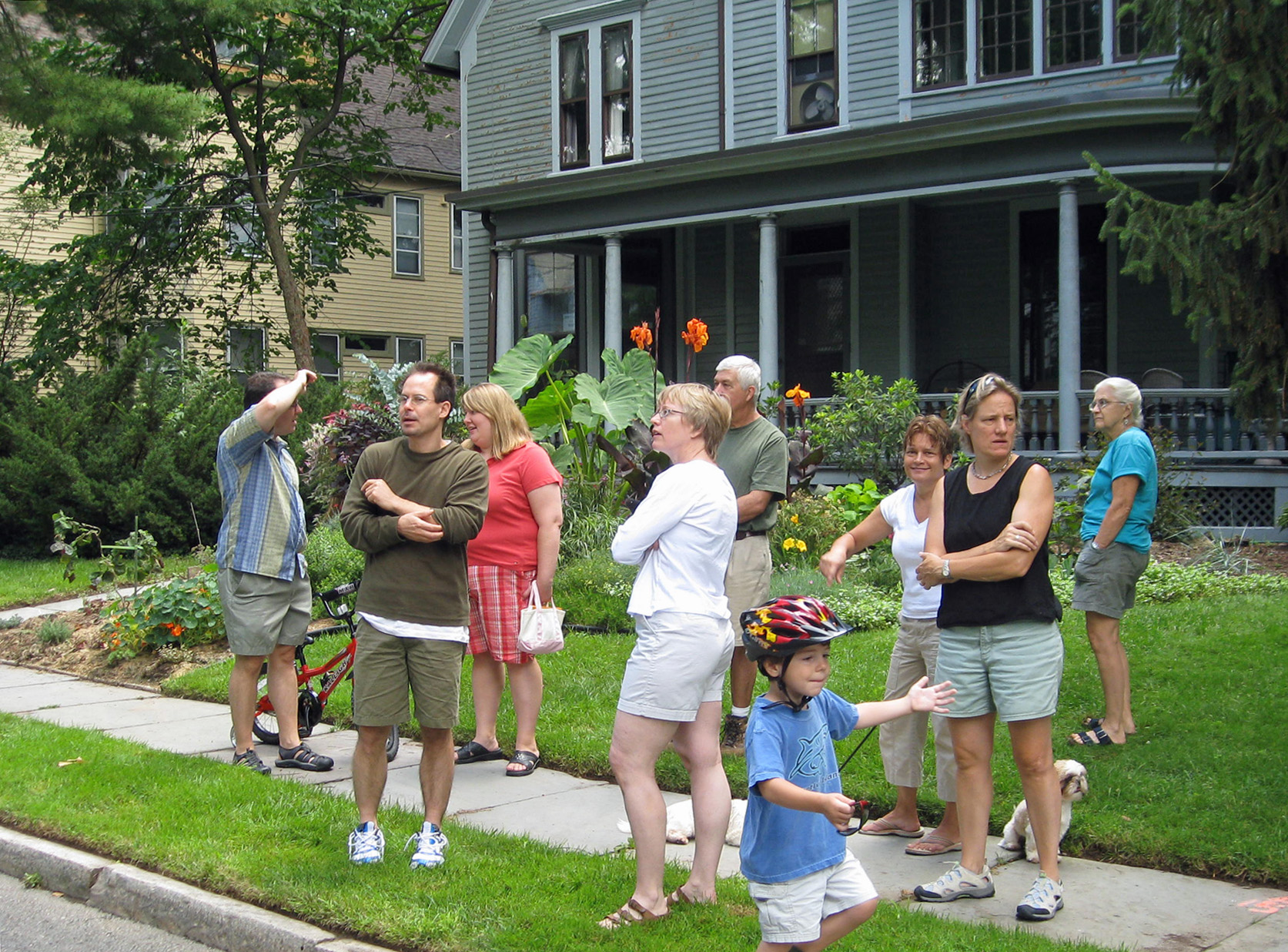
The Kenyon Street Garden Walk folks
trade secrets and plants.
Plants for:
Clay
Soil Dry
Areas Dry
2 Wet Areas
Wet
2 Moss
Shaded
Areas Shade
Perennials Shade
Annuals
Long
Blooming Perennials Low-Maintenance
Perennials Long
Lived Perennials Special Needs
Perennial
All-Star Book
Self-Seeding
Annuals Annuals from Seed
From Seed
Rooting
Plants Bulbs
to Naturalize
Trees to
Avoid 2
Trees
for Under-Planting Recommended
Street Trees
|
First Things
First: Use What You Have
|
|
|
- Focus on the front first -
Maintenance!.
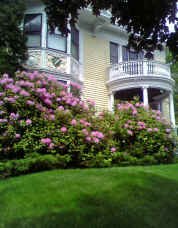
If it's perfectly maintained, whatever you have looks
better. Cut the lawn, edge the beds, pull the
weeds, shape the shrubs (paint the wood
steps).
- Keep what you have and
improve it.
An overbearing tree can be limbed from the bottom to frame
your house and provide light and air. It took
decades for that mature tree to grow. Keep the
advantages: a cooler house, cleaner air and more
inviting walk - just limb it, don't kill it.
Prune shrubs that have gotten gangly, too dense or
outsized. Arborvitae, rhodies, azeleas, privit - in
fact most shrubs can be heavily pruned to solve a
problem. Don't forget that the large lower branches
of shrubs can be beautifully sculptural if exposed by
removing foliage that will give you more space and
sunshine, but keep the living plant. If you want
more color, consider leaving the evergreens (pruned back)
and expanding the bed in front to plant colorful annuals
and perennials.
Move it. If you have a tree, shrub or perennial
hiding in the back, move it to a better, more visible
spot. If you can do this yourself, it's dirt cheap.
If not, compare the cost (and risk) of moving it, to
purchasing another large plant that you'll have to wait in
order for it to mature.
- Hanging Baskets
and Create a Focal Point.
 A
couple of well-placed hanging baskets, planting boxes or
earns out front (or in the back) can make a big impact for
little cost and maintenance. For the most
impact, choose annuals that have massed bright color that
look spectacular next to your house color. Choose
flowers that bloom all summer, or switch once from spring
to summer blooms A
couple of well-placed hanging baskets, planting boxes or
earns out front (or in the back) can make a big impact for
little cost and maintenance. For the most
impact, choose annuals that have massed bright color that
look spectacular next to your house color. Choose
flowers that bloom all summer, or switch once from spring
to summer blooms
Create a focal point. If your eye travels right to a
certain spot, all of the other areas fade into the
background. Two planting urns like these create a
focal point.
Or you can place a bench or bird feeder with a mulched bed
and few well-placed plants around it. Put it where
you want the eye to be drawn. Your yard will seem
more complete with the addition of only a few plants
surrounding a focal point. You can do the same with
a tree. Pick the most decorative or important tree
in your yard, and make it a focal point by adding a chair,
artifact or swing. Completing it with a couple of
well-chosen plants will make it stand out.
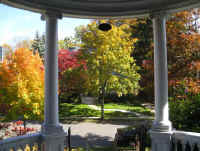
Color or combinations of color can provide a focal
point. A well-placed tree or shrub that lights
up the colors around it pulls your eye so that lots of
plant material become unnecessary. The same can be
said of dramatic spring-flowering trees and shrubs.
If you can choose a specimen with plum colored leaves
year-round, you'll have that effect year-round.
|
|
|
Choosing
Plants
West End Conditions:
Hartford is zone 6. Connecticut
soil is generally on the acid side. The West End
yard is likely to have clay soil. Most yards here have
wet areas, but dry areas under the house overhangs or dense
shrubs and trees. On average, it rains 1" a month -
ideal for most plants, but specific weeks can greatly exceed
that or have no rain, when you'll have to water.
Planting for trees is ideal in April-May and mid- September,
and October. Plant shrubs, annuals and perennials in May
or very early June. Plant shrubs, lawns and some
perennials in mid- September, October and early
November. Spring bulbs go in October and early-November
(or in a pinch, as long as the ground can be dug).
|
|
|
- Be Patient.
Plant the tree, shrub, perennial that will fit (with space
in between) when it's mature. Make sure you ask
how tall and how wide your plant will be at maturity.
You can always fill in with a few large low cost annuals
or perennials in the early years.
- Choose plants that will
thrive in your light and soil conditions.
It will die immediately (or peter out) if you don't put a
plant designed for the spot. Most people do the
opposite - they buy what they love, and then hope they
have a spot for it.
- Lots of tree roots? - only a
few ground
covers and plants will make it.

- Clay soil? - Amend with lots
of compost, sand, etc. or most plants will die. Plants
for clay.
- A large overhang where
rainwater never reaches? - better plant drought-tolerant
plants that don't
need a lot of moisture (lavender and lupine, are
examples).
- A fully shaded
area? - plant a big leafed hosta with smaller ones
of varied color. They're hard to kill, and they
come in lots of sizes and leaf colors. These
large blue hosta create a defining border to the
wooded area beyond. Or mix it up with other
shade choices like coral bells, brunnera or
fern. Perennials
for full shade. Impatients, New Guinea
impatients, and coleus are annuals
of choice for full shade.
- A low spot that's wet much of
the time? - You should solve
it, if you can (it's not going to get dryer on its
own). Or plant what wants to be there
anyway. Plants
for Wet Areas more
- Moss under that tree? - Make
areas under a tree or shady lawn areas that are
already mostly moss, a fully moss
area - you already know the conditions are
right. In short, go with what works.
Plants for Special Needs
- Choose fewer large or
fast-growing plants.
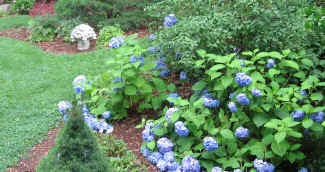 For
new plantings, choose fewer large plants to fill up a
large space. If they have long-running
blooms or fall color that compliment your house
color and style, so much the better. Rhododendrons,
mountain laurel and hydrangea 'endless summer' are some
examples of shrubs. For
new plantings, choose fewer large plants to fill up a
large space. If they have long-running
blooms or fall color that compliment your house
color and style, so much the better. Rhododendrons,
mountain laurel and hydrangea 'endless summer' are some
examples of shrubs.
Plant fast-spreading care-free
perennials (if you have a bed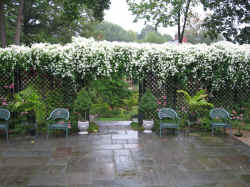 that can contain them). This handsome arbor (made
from stock items from Home Depot) is supporting just four
Sweet Autumn Clematis plants that matured within 2 or 3
years after planting. Echinacea, bee-balm,
daylilies, perennial geraniums such as 'Rosanne',
are some examples of fast-growing perennials that have
concentrated color and nice size.
that can contain them). This handsome arbor (made
from stock items from Home Depot) is supporting just four
Sweet Autumn Clematis plants that matured within 2 or 3
years after planting. Echinacea, bee-balm,
daylilies, perennial geraniums such as 'Rosanne',
are some examples of fast-growing perennials that have
concentrated color and nice size.
See Perennial
All-Stars for lists and information.
- Choose long-lived plants
that aren't susceptible to disease.
Annuals are only good for a year (save these
for well-placed punch and pay attention to the specific
variety. For example, Tidal Wave petunias can
provide a mass explosion of color from just a plant or
two. Regular petunias do not.) Or choose self-seeding
annuals, that will grow next year from their own
seeds. NOTE: Do not deadhead at the end of the
season, or you won't get seeds. You will have to
transplant 'volunteers' that fall where they may. Or
collect the seeds in an envelope (label it) and spread
them where you want them in the fall.
 Bulbs
can naturalize and spread or only last a season.
If you want them to keep coming, plant naturalizing
daffodils, hyacinth, snow drops. Tulips only
last a year (or less if the squirrels get them) - some of
the tall "Impression" and early "Kaufmannia"
tulips can last two or three years. Crocus can last
a long time, but only where the squirrels can't get them -
like under the grass. Hint: wherever you plant
a ground cover, plant daffs underneath. Mine have
lasted decades without maintenance. You can surround
your tasty tulips with daffs, which are poisonous to
squirrels. Bulbs
can naturalize and spread or only last a season.
If you want them to keep coming, plant naturalizing
daffodils, hyacinth, snow drops. Tulips only
last a year (or less if the squirrels get them) - some of
the tall "Impression" and early "Kaufmannia"
tulips can last two or three years. Crocus can last
a long time, but only where the squirrels can't get them -
like under the grass. Hint: wherever you plant
a ground cover, plant daffs underneath. Mine have
lasted decades without maintenance. You can surround
your tasty tulips with daffs, which are poisonous to
squirrels.
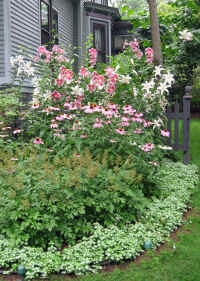 Perennials
can live for a century or more (certain roses, peonies,
for example). These lilies, Echinacea, astilbe and
lamium form a terraced border that has been here over 25
years - quite maintenance-free. Some
perennials only live a couple of seasons (violas,
columbine). Here's a info on long
lived perennials. Perennials
can live for a century or more (certain roses, peonies,
for example). These lilies, Echinacea, astilbe and
lamium form a terraced border that has been here over 25
years - quite maintenance-free. Some
perennials only live a couple of seasons (violas,
columbine). Here's a info on long
lived perennials.
Shrubs. Most shrubs are long-lived if put
in the right spot for light, water and soil conditions.
Trees. Short-lived trees can live for
only 10 years, especially if they are susceptible to
disease. (Lombardy Poplar which grows fast, Mountain
Ash, for example). I have seen both of these grow
and die with the same owner who planted them for 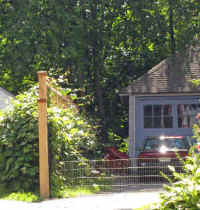 screening.
The owner could have planted a less expensive shrub or
vine that would still be screening the desired area long
after those poplars died. screening.
The owner could have planted a less expensive shrub or
vine that would still be screening the desired area long
after those poplars died.
Here was a short, mature grape arbor, that was just put on
a taller arbor to provide the height of screening these
owners desired. Grapes are so vigorous, it filled in
to the new height that same year.
Smaller ornamental trees such as Dogwood have a normal
life of 30 years and can be susceptible to disease.
A Japanese Maple of the same height can live live for
hundreds of years. Here
are trees to avoid. Recommended
Street Trees.
- Do NOT scrimp on soil
preparation!
See Planting
a Tree to learn how Knox Parks Foundation does it.
See planting tips, below for preparing a new perennial
bed, and maintaining it.
Choosing a low-maintenance design and these sure-fire plants
will keep maintenance costs to a minimum.
|
|
|
Beg, Buy or
Plant Low-Cost
|
|
|
- Join or form a garden group.
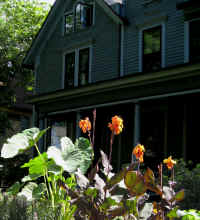 The
cheapest plants are from your own yard - or are given by a
friend or relative. Ask for a division, seedling or
cutting if you see a plant you like! Both
these large orange cannas and the elephant ears came from
divided plants from another Kenyon St. gardener.
They filled nearly the entire new front bed. The
cheapest plants are from your own yard - or are given by a
friend or relative. Ask for a division, seedling or
cutting if you see a plant you like! Both
these large orange cannas and the elephant ears came from
divided plants from another Kenyon St. gardener.
They filled nearly the entire new front bed.
Learn to divide those perennials: how and when.
You're going to have to divide most of them anyway.
When your perennial plants start to peter out, or get a
dead spot in the center of a clump, it means they are too
crowded and are beginning to die. Decide ahead of
time where the extras are going to go: make a new or
expanded bed, have an overflow bed for cut flowers, give
them away, sell them, or gasp! compost them if they're not
diseased.
- Plant from Seed.
Learn what you can root.
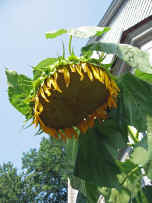
Collect seeds from yours and others plants - or pop for
the $2.35 and buy a packet of seeds. March is
usually seed-starting time here, so you'll need to think
about where to start them. Start with the easy
ones - like sunflower seeds or marigolds. This
giant sunflower was grown from seed. Best
Annual Flowers to Start from Seed Best
Flowers to Start from Seed Rooting
Plants
- Buy plants in bulk at
discount prices.
Don't need that discounted collection of 100 bulbs, but
two or three of you are interested? There's a 30%
discount if you buy three? Get a friend.
Discount catalogues can be a good deal, but may not
be. Get recommendations from your friends.
- Find a charity plant sale -
or have one yourself!
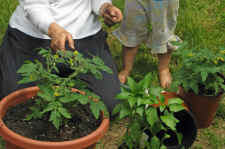 Many
school fairs and community organizations sell plants as a
part of their fundraiser. May Fair at Noah
Webster School usually has a plant sale table. Many
school fairs and community organizations sell plants as a
part of their fundraiser. May Fair at Noah
Webster School usually has a plant sale table.
Or, use all those pots you collect to pot up your
extra perennials (Clean pots with 10% bleach solution
first). Tell all your friends the sale date, and
donate the proceeds to charity. Convince your
friends to join you, and you can buy their plants
at discount. One group sells every year and donates
the funds to cancer research.
|
|
|
Sources for
Low-Cost
(Hartford)
|
|
|
- Knox Parks Foundation Street
Tree Planting.
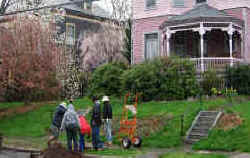
Your group supplies the labor, Knox supplies the trees,
material and heavy equipment. This group is planting
a Bradford Pear on Knox's tree planting day on Kenyon St.
in 2006. This is one of 25 trees planted that day.
- Free compost at Hartford
Public Works
May and early June, go to the public works yard off of
Jennings Road near Riverside Park during business
hours. You shovel it and truck it. Bring old
laundry baskets, leaf bags, etc. They'll usually be
able to help load your car.
- Make your own compost.
Lost of sites can tell you how. You need to
turn it every week or so and have a spot.
- Tag Sales, Craig's List,
FreeCycle, Trash Day
Get free or cheap garden ornaments, pots, furniture,
plants, etc. by being observant.
- Elizabeth Park and Knox
Parks both sell discounted plants.
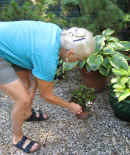 Check
times in the Elizabeth Park calendar for their sales of: Bulbs
(April & June), Check
times in the Elizabeth Park calendar for their sales of: Bulbs
(April & June),
Perennials (May), Dahlia Bulbs (May), Iris and Herbs
(May). Check the Knox website for their perennial
plant sale.
- 6. Grocery
stores and discount sources.
If you know what you want,
check out the prices at the grocery store - right when
they first come out.
These stores hold on to their stock and usually don't have
the
staff or expertise to keep
the plants healthy for long.
- Buy in late fall.
Most garden centers discount healthy trees and shrubs
later in the fall - when it is still the best time to
plant. Most discount annuals and perennials in
June-July. Ask if you can have that plant that fell
off the truck. If it's damaged and can't be sold,
some will let you have it free, or heavily
discounted. Or find a friend who works at one.....
- Stores that have a 100%
guarantee on all material.
Home Depot and Lowe's both refund 100% if your tree,
shrub, perennial or annual doesn't make it. Ask at
your garden center - keep receipts, and then take the
trouble to ask for the refund.
|
|
----
 ----
----
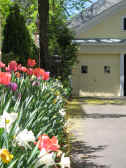 Garden
Design & Maintenance:
Garden
Design & Maintenance: 
Download comprehensive Garden
Design Tips
Basic
Considerations
How will you use
your yard?
What style do
you have/want (Victorian, English cottage, French,
Japanese)?
Where are the views from inside and outside? What are the problems?
Where do you have/want shade... Where do you have/want sun?
Where do you want privacy? Where do you want
to sit? Where do you want
utilities (lighting, trash, compost, faucet)
Edibles, flowers, low-maintenance design? Encourage
birds, bees, butterflies?
Energy-sustainability considerations: Deciduous
trees on the south side, evergreen trees on the north
side. Plant species native
to Connecticut.
How much work can you handle? Do not
plant high maintenance beds in front or in hard to weed
spots.
What is your budget? Do one section at a
time? Plant front first.
Make a bird's-eye sketch with your house in the middle (show north) -
add arrows showing your basic considerations.
Scale,
Color, Bloom Time
Pick the shape, ultimate size
& color
that fits your sunny, part-sun or shady area. Note
that as trees and tall shrubs grow, sun will turn to shade
conditions.
Full
Sun: (6-8 hrs of sun.), Part Sun: (4-6 hrs.), Shade: (1-4
hrs.)
Scale: Oversized or crowded plants, trees and shrubs soon become a maintenance
headache, so pick the ultimate size first!
Choose evergreen for year-round privacy, shade and
background. Fencing, vines on tall lattice, and
artwork can provide privacy, too.
Color:
What is your color scheme? Using at least two
sympathetic colors in proximity more than doubles the
impact.
What house color or other background is there?
Very important.
What are the colors and bloom times of the surrounding
plants?
Leaf color and textures (silvers, grays, reds and browns break up the mass of
green). Don't forget fall foliage color
combinations!
Timing:
When do you want the bloom color (spring, summer, fall -
continuous)? Don't pick a bloom time you are
never there. Spring and fall colors used in
locations you can see from inside extends your
enjoyment. Place summer blooms where you can enjoy
them where you sit outside. Continuous color will
not be concentrated if it's all in one bed.
Make a design showing shape, height and color of materials
for your planting area. Show the height and
color of the background house or plantings, too.
Identify
Specific Plants
(See Lower-Cost
Gardening, above for general conditions in Hartford,
lists of low-maintenance plants and "How-To".)
Sun vs Shade
plants is usually the first cut.
Shade (1-3 hrs),
partial shade (3-6 hrs.) or sun (6-8 hrs.)
Wet or dry conditions: If you have a bog, plant
bog plants. Don't mix dry-loving plants next to
those that need plenty of water. Fungus indicates over watering
or endless rain.
Heavily fertilize vs No fertilize requirements:
Try not to alternate plants with different fertilizer
requirements - keep them in groups. Fertilizing 'easy-care' plants like Echinacea
will boost the leaf production and they'll barely bloom.
Fertilizer is essential for some, like lilies and roses. Lime
vs acid-loving plants: Neutral soil has a
pH value from 6.5 to 7.0, which is what to aim for in
most perennial beds. pH
levels for plants.
Rapidly spreading plants: If you don't want
to have to dig rapidly expanding plants, plant them where
they can expand at will. Root-expanding plants like
some fern, lily of the valley, bee balm and ground covers
like pachysandra can be stopped by a below-ground border barrier. Hint for mint lovers: Mint is
invasive. Plant it in the ground in a pot within a
pot - put a plastic bag in between the pots as a barrier.
Remarkably, it survives this way year after year. Seed-expanding plants like Echinacea will
spread into any prepared beds where the seed falls.
Do not plant 'pest plants'. Consider removing
them. Invasive
species will become the scourge of the neighborhood,
the state..... http://www.ct.nrcs.usda.gov/plants.html.
Plant species native
to Connecticut.
Special Considerations such as root competition. Certain
plants are happy under trees, others are not. Hosta
can survive most any condition.
Identify specific plants that fit the spot (for
conditions, shape, size and color). See lists,
above.
Draw
a bird's-eye plan giving each plant its required space - fill in with
annuals between newly planted perennials at first.
Planting
and Soil Preparation
Wear
sunscreen, gloves and a hat!
See
Nancy DuBrule's advice on starting a perennial bed.
When:
Fall planting (after the hot days have passed) is best for
lawns, shrubs and perennials to give roots a good head
start.. The first week of October is usually optimal
for planting. Spring planting is next best.
Generally, plant when the soil is no longer saturated, but
crumbles, and after danger of hard frost, in Hartford about
May 1 to 15. Plant annuals and vegetables in
May. To plant trees, see Knox
Tree Planting and Tree
Pruning and Maintenance. Test
the Soil and Augment: Do
a soil test to see if your soil
is overly acid or alkaline. Most
plants prefer neutral soil (pH of 6.5-7.0), but there are exceptions.
Lilacs like alkaline soil (spread some lime). Rhododendron,
azaleas and most evergreens
like acid soil (fertilize with fertilizer specifically
for acid-loving plants. Some
people use oak leaves, some research says this is a myth.)
pH
levels for plants. A light side dressing of
compost and dried manure (5-3-4) in early spring spring both
fertilizes and tends to
bring soil in our area to neutral. Here, large amounts
of compost are required to enrich, neutralize and lighten
clay soil when first preparing a bed. For planting
acid-loving plants such as rhododendrons and azaleas augment
the soil with peat moss instead of compost.
Add rock phosphate deep into the soil when first preparing a
garden bed. Nancy DuBrule also adds greensand when
first beginning a perennial bed to develop strong root
systems. Use a soil tester (at
most garden centers)
and read the bag label instructions for specific quantities
needed.
UConn Cooperative Extension Service also tests soil. They
are at 1800 Asylum Ave
(at Trout Brook in W. Hfd – opposite the UConn main
parking lot). Rule of thumb: add some lime if
it's too acid, extra manure if it's too alkaline.
Layout the
Bed, Create a Lawn Barrier:
Use a hose to layout the location of your new bed. If
your bed abuts a lawn, cut in a continuous barrier line the
depth of your shovel all along the boundary. The
barrier should be about three inches wide, sloping up
towards the bed. Never let the grass cross - your bed
will be very hard to maintain once grass infiltrates the
bed. A plastic or metal barrier is more expensive and
harder to install, but permanently keeps the
separation. A brick barrier is pretty, but sinks,
collects weeds and mold and doesn't keep the grass out. In any
case, get rid of any live grass or weeds from your bed by digging
down and under the grass and roots
with a flat shovel or a sod cutter. You can also kill the
grass/weeds in the bed by first by
smothering your patch with black plastic (garbage bags held
by wire stakes or rocks
over several weeks.) Compost the discarded grass. If
you have wet areas, avoid this location, or plant a bog
species. If the location is unavoidable, several inches of gravel
below the top 18" of soil will help keep topsoil
from being saturated. Change the soil level to redirect
or distribute water so it doesn't collect (mosquitoes can
breed in very little water, including soil that's always
muddy. For minor problems, augmenting your soil with
enough sand and compost may be all you need.
Dig the
Bed, Compost: Prepare the soil well or you're wasting
your time. Turn the soil over with a shovel
and pitchfork to
loosen and aerate it - down at least a spade's depth - best
to dig down 18". Either transplant any grass to
fill a bald spot in your lawn, or shake off the dirt and
compost the grass. Add 3" of compost over the
whole bed and mix it all the way in. You may need more compost and
manure, possibly sand if your soil is heavy or part clay.
Discard rocks and break up clods. For a new perennial
bed, Smooth the surface
so it drains away from the house. Top dress with dried
manure which fertilizes (sheep manure is best, but chicken
is
good, too.) Check the package label for
quantities. Mix it in the top inch or two. Plant,
Water: Lay out the plants
according to your design. When
you buy the plant – ask how far apart they should be.
Follow label instructions to plant seeds. (for
seeds, press a shovel handle in the soil to give you a straight
planting line.) You
typically plant the seed
with ½” or less of soil on top, pressing gently to make
good contact with the
soil. Seeds differ, but most come up in a week or two. You
will plant more seeds
than you need, so you will thin the seedlings that become
established.
For potted plants, make sure the soil level matches the level
of the bed. If root-bound in the pot, slice the bottom
1/3 of the roots into four flaps, and spread the flaps when
planting. Pat it in to make sure the roots are in
good contact with the soil. Create a little dam on the
sloping side to catch the water.
Give your new plants or seeds a
long drink with a gentle light spray. To check if
you’ve watered enough, stick your finger in the soil to
make sure the soil is wet
to about 2” when first planting. Water again in half a
week after first planting
if the soil dries out or daily if your plants are drooping.
Thereafter you need 1”
of water a week – from nature or the sprinkler.
Pfaus Hardware has gauges for about $3.
Pinch off the top set of leaves when planting to produce a
fuller plant. This encourages side growth. Mulch:
Put 2
" of shredded pine bark mulch around the plants, and
over the whole bed. Keep mulch from touching the
actual plant. Mulch retains moisture and keeps
the weeds down.
If you have planted seeds in the ground, spread 1/2" of
compost as mulch to get them started. Pull or move
the extra seedlings in between once they grow several inches
in order to get the proper spacing between
plants.
General
Maintenance Schedule
Download
also
see - Garden
Clubs of CT list Month-by-Month
-
Late
Sept-Oct:
Weed in fall
to keep weeds from getting a foothold.
Dig in compost to make soil lighter and better, if
desired.
Spread grass seed w/ a little potting soil over bald spots
(after scratching the dirt).
If it's a dry fall, water deeply in late October so plants go into winter
hydrated.
See below for dividing perennials.
-
November-Dec.
(after hard frost)
Cut dead perennial plants down. Compost disease-free
ones.
Bank mulch around plants that are not hardy to protect
from wide temperature shifts.
Protect young evergreen shrubs from bending with heavy
snowfall (twine, tent, etc.)
-
April:
After it rains, pull weeds, or use a weed blade tool where
weeds are clustered.
Add a side dressing of chicken manure each spring around
your plants (and compost to lighten your soil), or
Hollytone for acid-loving plants (rhododendron, azelea,
andromeda, mountain laurel, fir, cedar, spruce, hemlock,
holly, hydrangea, viburnam, magnolia, dogwood,
oak, etc. are all acid-loving) pH
levels for plants
Spread
Preen if you like extra help to keep weeds down.
-
Late May:
Mulch (shredded pine bark) is our
friend - about 2". A late mulch lets you find
seeds that have sprouted.
Cage or stake any plants that need support (tall lilies,
delphinium, peonies, dahlias)
Plant heat-loving tomatoes and peppers in late May.
Plant summer bulbs like dahlias now. HINT: in Hartford,
if you plant gladiola bulbs 9" deep, especially if
near your foundation, we have found them to be hardy,
blooming year after year without having to remove them.
-
June:
Fertilize: Only certain plants benefit from post-spring bloom fertilizer: like lilies, delphinium,
roses, reblooming bearded iris...
Deadhead: Deadheading means
twisting or clipping the dead flower off the plant as
soon as it’s gone. Deadhead
lilacs and spring bloomers to encourage growth, pinching
spent blooms from your rhododendron will net more blooms
next year. Deadhead repeat bloomers like Salvia
'May Night' and Nepeta
to encourage repeat bloom later in the season.
Hard
Trim: Some early-blooming perennials that form a
basal rosette of growth may tend to become large and
floppy with age. Trim them back hard after bloom is
finished – you will quickly get handsome foliage that
will remain compact all summer. Candidates include: Alchemilla
(Lady's Mantle), Cranesbill
(Geranium), Aquilegia (Columbine), Tiarella,
and Heuchera.
Half-Trim: I f you have any of the glorious
tall, fall-blooming Asters,
such as 'Alma
Potschke', you can trim them back by half this month.
Just do so by the end of June. Plants will still bloom,
but will be more compact than their usual 3-4ft
heights. This
is also useful for higher growing sedum like Autumn Joy,
if you have found your sedum to be leggy or droopy in the
fall.
Narcissus Leaves. Leave the browning daffodil
leaves alone. They should be allowed to remain at
least six weeks after bloom, to feed the bulb for next
spring's show. It is ideal to let the foliage wither
by itself. If it's been 6 weeks since the blooms
faded, you can trim the leaves if you can't stand it.
-
Ongoing:
Weed as you walk! (easy after it's saturated
with rain). Maintenance out front!
Keep lawn tidy. See "Create a Lawn Barrier",
above.
Water: Rule of thumb-you need about 1" of rain or
watering per week for most annuals and perennials. CT gets an average 1" a
week, but if 1.5 weeks passes without an inch, water your
plants. (A 'V' shaped rain gauge is helpful. Use it
also to learn how long to sprinkle to achieve 1".
I water a 6' swath with a gentle hose for about 1.5
minutes to achieve 1/2".) Do
not sprinkle your porch or siding - a sure way to rot
expensive details to replace.
Collecting
Seeds
If you want to collect seeds to start for next year,
leave a few dead flowers that will go to seed. Collect
them in envelopes from
the dried pod. Label the envelope so you know what’s in
there. Or just let the seeds
drop and when they emerge in the spring, transplant
them where you want them. Perennials that easily reseed
include foxgloves, cone flower and black-eyed susans which make small plants this year,
ready to bloom next year. Annuals that reseed
include cleome, cosmos and snap dragons.
-
July-August:
Every 2 weeks spray diluted liquid seaweed on rose leaves
to keep them healthy.
In years of high heat and drought, spray fish emulsion
once or twice on all areas. Attach a proportioner to
your hose, and you will fertilize as you water.
-
Anytime:
Cut flowers to enjoy indoors.
Pruning and
Dividing.
Mid-Fall
Divide perennials
that are crowded, usually every 3-4 years. Otherwise
the plant and surrounding plants will stop blooming and
may eventually die. To divide, gently dig around and
pull up plant root shaking off the dirt. Lightly trim tops and roots.
With a disinfected knife (use Lysol, an antibacterial mouthwash such as
Listerine, or rubbing alcohol), cut in half
vertically along the root division, or divide into more
plants, as appropriate. Replant one in original
spot. For remaining sections, plant in new location,
plant in holding garden out back, pot or give to a friend.
Example of specific instructions: Transplant bearded
iris in the fall, keeping them from being crowded by other
perennials. Cut bearded iris back to 3-4" and
remove spent foliage to discourage borers.
Early
Spring
Prune roses in early spring.
Cut
clematis that bloom on new wood back to 18" each spring
(or at least every 3 or 4 years). Clematis that
bloom on either old or new wood should have dead wood
removed and light pruning each year to keep some blooms at
eye level - severely back to 18" after the first
bloom to rejuvenate an old plant. (See WWF document
to see varieties of each type)
Pruning Trees: Two or three years after planting, it's
generally safe to prune. Any earlier, and it may be
losing vital moisture before deep roots are
established. Trees grow from the tips, so
a branch 10" from the bottom will always be 10"
from the bottom, only growing thicker as the years
pass. So, if you want to walk under a tree,
eventually remove the branches under about 6
feet. Immediately prune to remove branches that are
dead, or those that can damage a tree by rubbing another
branch, branches that shoot straight up or cross another, to
encourage growth in a certain direction, and to uncover the
basic shape so branches have room to grow thick. Rule
of thumb: prune enough so a bird can fly
through. Leave enough leafing so the tree can sustain
itself. Prune also for aesthetics or if a branch will
eventually hit the house, for example. If you can foresee
that a branch will become a problem, getting rid of it now
will save a much more expensive removal later, and the tree
will put it's energy into growing where you want it to. See Tree
Pruning and Maintenance
for an illustrated guide.
Pruning Shrubs:
Most shrubs grow from the tips or budding directly off the
main branches. Generally speaking, you can prune
shrubs way back and they will branch out and become
fuller. For example, if a Rhody or Mt. Laurel is
getting scraggly, oversized or blocking your view, cut the
branches back below where you want it to grow back to get
fuller branching. The same is true of a privit hedge
that has gotten thin or too tall. Whack it back to a
foot if you like. Privit shrubs can grow to 25'
if left unattended. Arborvitae can be topped,
thinned, sculpted or cut near the ground to re-grow.
See Pruning
Arborvitae for more specifics.
Anytime
Thin and Cut
Back: Some perennials spread way out of their
zone, killing, crowding out or shading others you want to
maintain. Pull them, dig them out or prune back, as
necessary. Infamous encroachers include, cone flowers
and black-eyed susans, ivy, lily-of-the-valley, bee balm.
----
 ----
----
Resources:
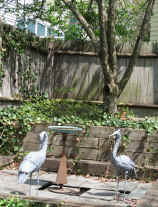

Elizabeth
Park: Overwintering
Roses glossary
Winter Lectures
Native
Gardens "Green"
gardening Tree
Tour
UConn
Coop Extension Service Hartford
office home-garden
soil
test plant-insect
test fact
sheets plant
database
master
gardeners seminars
CT
Agricultural Experiment Station
CT
Horticultural Society Master Gardener Links
Garden
Centers-Books
WFF
Weekly Garden Tips
rose
planting & care Lloyd
Border
Climate
Change in the Garden
Video How-Tos:
Collecting
hollyhock seeds
Connecticut
Gardener Articles Federated
Garden Clubs of CT Monthly To-Do List
The
Seed Savers Exchange (save
and exchange heirloom seeds)
Planting
and Maintaining Trees - our Knox
photo-journal
Annual
February Flower Show
(lectures) North-Central
CT Conservation District Plant Sale (early April
deadline)
For those who have Japanese beetles eating your roses - Doug
reports great success by using a product:
Spectracide:
Systemic Rose & Flowering Shrub Insect Control +
Fertilizer.
Hydrangeas Kenyon
Street Pests:
Cedar-Apple-Rust
Fungus
Red Lily Beetle Summary
Japanese
Beetles on Roses
----
 ----
----
Kenyon
Garden Walk Photos: 
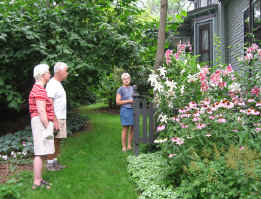
Click here
to see photos of our Kenyon Garden Walks 
  Return to top
Return to top
|
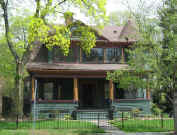
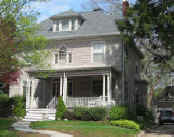
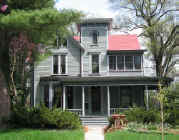

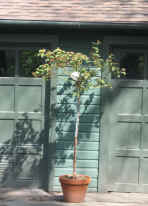

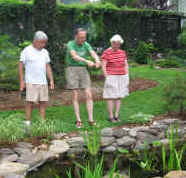
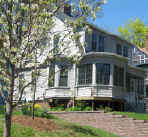
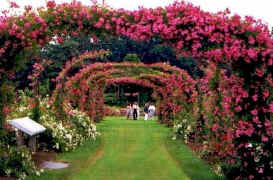




 A
couple of well-placed hanging baskets, planting boxes or
earns out front (or in the back) can make a big impact for
little cost and maintenance. For the most
impact, choose annuals that have massed bright color that
look spectacular next to your house color. Choose
flowers that bloom all summer, or switch once from spring
to summer blooms
A
couple of well-placed hanging baskets, planting boxes or
earns out front (or in the back) can make a big impact for
little cost and maintenance. For the most
impact, choose annuals that have massed bright color that
look spectacular next to your house color. Choose
flowers that bloom all summer, or switch once from spring
to summer blooms

 For
new plantings, choose fewer large plants to fill up a
large space. If they have
For
new plantings, choose fewer large plants to fill up a
large space. If they have  that can contain them). This handsome arbor (made
from stock items from Home Depot) is supporting just four
Sweet Autumn Clematis plants that matured within 2 or 3
years after planting. Echinacea, bee-balm,
daylilies, perennial geraniums such as 'Rosanne',
are some examples of fast-growing perennials that have
concentrated color and nice size.
that can contain them). This handsome arbor (made
from stock items from Home Depot) is supporting just four
Sweet Autumn Clematis plants that matured within 2 or 3
years after planting. Echinacea, bee-balm,
daylilies, perennial geraniums such as 'Rosanne',
are some examples of fast-growing perennials that have
concentrated color and nice size.  Bulbs
can naturalize and spread or only last a season.
If you want them to keep coming, plant
Bulbs
can naturalize and spread or only last a season.
If you want them to keep coming, plant  Perennials
can live for a century or more (certain roses, peonies,
for example). These lilies, Echinacea, astilbe and
lamium form a terraced border that has been here over 25
years - quite maintenance-free. Some
perennials only live a couple of seasons (violas,
columbine). Here's a info on
Perennials
can live for a century or more (certain roses, peonies,
for example). These lilies, Echinacea, astilbe and
lamium form a terraced border that has been here over 25
years - quite maintenance-free. Some
perennials only live a couple of seasons (violas,
columbine). Here's a info on  screening.
The owner could have planted a less expensive shrub or
vine that would still be screening the desired area long
after those poplars died.
screening.
The owner could have planted a less expensive shrub or
vine that would still be screening the desired area long
after those poplars died.  The
cheapest plants are from your own yard - or are given by a
friend or relative. Ask for a division, seedling or
cutting if you see a plant you like! Both
these large orange cannas and the elephant ears came from
divided plants from another Kenyon St. gardener.
They filled nearly the entire new front bed.
The
cheapest plants are from your own yard - or are given by a
friend or relative. Ask for a division, seedling or
cutting if you see a plant you like! Both
these large orange cannas and the elephant ears came from
divided plants from another Kenyon St. gardener.
They filled nearly the entire new front bed.
 Many
school fairs and community organizations sell plants as a
part of their fundraiser. May Fair at Noah
Webster School usually has a plant sale table.
Many
school fairs and community organizations sell plants as a
part of their fundraiser. May Fair at Noah
Webster School usually has a plant sale table. 
 Check
times in the Elizabeth Park calendar for their sales of: Bulbs
(April & June),
Check
times in the Elizabeth Park calendar for their sales of: Bulbs
(April & June), 